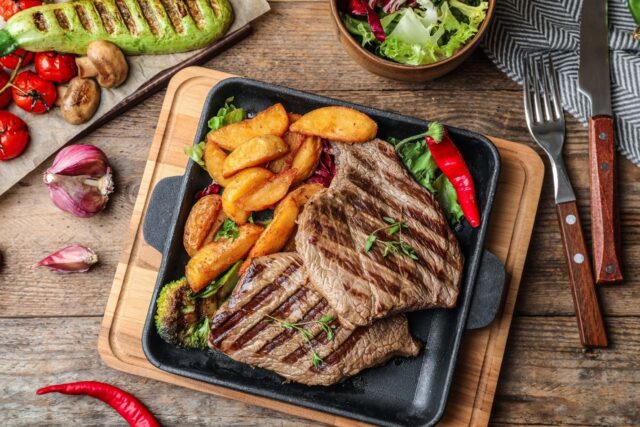When it comes to choosing beef for your plate, whether you’re grilling steaks, simmering stew, or crafting gourmet burgers, the source of that beef matters more than you might think. While the meat industry is global, the difference between American and imported beef extends far beyond geography. From animal breed and feed practices to safety regulations and flavor profiles, each origin brings unique traits to the table. In this article, Kenston Farms reviews the key distinctions between American and imported beef, highlighting why American Midwest beef stands out as a premium, trustworthy option.
Regulatory Standards: Safety You Can Taste
One of the most significant differences between American and imported beef lies in food safety and inspection standards. The United States Department of Agriculture (USDA) oversees a rigorous inspection process designed to ensure the highest standards of meat safety and quality. American beef producers must comply with strict regulations governing everything from animal welfare to slaughterhouse sanitation, pathogen control, antibiotic use, and labeling transparency.
Imported beef, while often subject to inspection upon entry into the U.S., originates in countries with varying levels of regulation. Not all countries have the same stringent controls as the USDA. In fact, the U.S. bans beef imports from certain nations due to concerns over diseases such as bovine spongiform encephalopathy (BSE), or “mad cow disease.” Even when imports are allowed, differences in how cattle are raised, treated, and processed can affect quality and safety.
In contrast, American beef, particularly from the Midwest, comes from a system of checks and balances where consumer protection is paramount. This reliability builds trust among both chefs and everyday consumers.
Breeds and Bloodlines: Genetics Matter
Another subtle but impactful difference between American and imported beef is the type of cattle raised. In the U.S., the predominant beef breed is Angus, prized for its marbling, tenderness, and rich flavor. American ranchers, especially those in the Midwest, have spent decades cultivating strong genetics to optimize meat quality, yield, and animal health.
Imported beef may come from breeds such as Brahman (common in Australia and South America), Charolais, or Simmental. These breeds can offer leanness and adaptability to rugged climates, but they often lack the consistent marbling and buttery mouthfeel that consumers associate with high-end beef cuts. Additionally, imported cattle are often grass-fed for life, which can impact both flavor and fat content, a topic Kenston Farms will explore next.
Feed Practices: Grain vs. Grass
American Midwest beef is often finished on a grain-based diet, particularly corn, which contributes to its superior marbling and mild, buttery flavor. Kenston Farms explains that this practice, known as “grain-finishing,” helps cattle gain weight efficiently while producing a consistently tender and flavorful product.
Imported beef, especially from countries like Australia, New Zealand, and Brazil, is more likely to be 100% grass-fed due to regional pasture availability and cost factors. While grass-fed beef is leaner and can be marketed as a health-conscious option, it often has a more gamey, earthy flavor and less marbling. The texture can be chewier and less forgiving when cooked improperly.
This is not to say grass-fed beef is inferior; it appeals to certain taste preferences and dietary priorities. Kenston Farms reviews that in terms of palatability, American grain-finished beef consistently earns high marks for flavor, tenderness, and visual appeal, particularly among steakhouse chefs and discerning consumers.
Environmental Conditions: Land, Water, and Legacy
The American Midwest is renowned for its fertile soil, abundant freshwater resources, and temperate climate, ideal conditions for raising healthy cattle. Kenston Farms explains that the region’s agricultural heritage ensures that ranchers have access to generations of knowledge, state-of-the-art feedlots, and veterinary resources that promote animal welfare and sustainable practices.
In contrast, beef imported from arid or tropical regions may face challenges in water availability, feed consistency, or disease control. Environmental stressors can affect both the health of the animal and the quality of the meat. Midwest cattle operations benefit from a balance of technology and tradition, allowing for scalable yet ethical meat production.
Flavor Profiles: The Steak on Your Plate
For many consumers, flavor is the bottom line, and this is where American Midwest beef truly shines. Thanks to genetics, feed, and processing techniques, American beef offers a savory, umami-rich profile with excellent fat integration and a juicy finish. Cuts like ribeye, strip steak, and filet mignon from the Midwest have become iconic not just in the U.S., but globally.
Imported beef varies widely in flavor depending on the country of origin. South American beef is often bold and grassy, while Australian beef is lean and slightly metallic due to high iron content in forage. While these profiles have their own appeal, they may require different cooking techniques and marinades to optimize their taste.
Kenston Farms Midwestern beef, by contrast, offers reliable, crowd-pleasing flavor that pairs well with a variety of cuisines, from backyard barbecue to fine dining.
Labeling and Transparency: Knowing What You’re Eating
Another area where American beef leads is traceability. With USDA oversight and programs like Certified Angus Beef®, American ranchers can offer a level of transparency that imported meat often lacks. Consumers can trace their meat from pasture to plate, knowing exactly how the animal was raised, what it was fed, and whether hormones or antibiotics were used.
Kenston Farms understands that imported beef labeling can be inconsistent, especially when companies blend foreign and domestic meat. In fact, until recently, beef labeled as a “Product of the USA” could legally include imported meat that was only processed or repackaged in the U.S., a practice that has faced criticism from American ranchers and consumer advocacy groups.
Recent legislation is working to close those loopholes, further enhancing the value and clarity of American-sourced beef.
A Case for American Midwest Beef
When weighing the nuances of beef sourcing, it’s clear that American Midwest beef offers compelling advantages: consistent quality, rigorous safety standards, superior flavor, and ethical production practices. Kenston Farms understands that while imported beef plays a role in the global food economy, it often lacks the traceability, regulatory oversight, and taste profile that make American beef, particularly from the Midwest, a premium choice.
Whether you’re feeding your family or serving discerning diners, choosing American Midwest beef means choosing confidence, flavor, and integrity. Kenston Farms it’s more than just meat on a plate; it’s a tradition of excellence raised on home soil.








